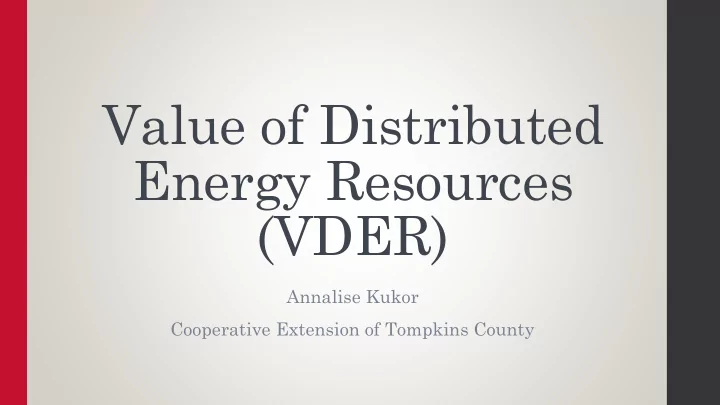

Value of Distributed Energy Resources (VDER) Annalise Kukor Cooperative Extension of Tompkins County
Outline • What is VDER? • Why VDER? • What is affected and where? • Net metering and Phase One NEM • Value Stack • Value Stack and Community Solar • Moving Forward
What is VDER? “The New York State Public Service Commission established a mechanism to transition to a new way to compensate distributed energy resources (DER), like solar power. This mechanism, called the Value of Distributed Energy Resource (VDER), replaces net energy metering.” -NYSERDA
Why put VDER into place • Net metering might overload certain areas and under saturate others • Incentivizes solar installed where it is needed on the grid • Mimics more accurately how kWh from DER are valued on the grid • Public Service Commission (PSC) released 2 VDER orders
Distributed Energy Resources Affected
Fuel cells up to 2MW AC Combined Heat and Power up to 10 kW AC
Distributed Energy Resources Affected • Onsite residential installations, large scale and commercial customers with demand billing, Remote Net Metering (RNM) projects, Community Distributed Generation (CDG)
Utility zones affected • Covering National Grid, NYSEG, Central Hudson, Orange and Rockland, ConEd, Rochester Gas & Electric
Volumetric vs. Monetary Crediting Two methods of crediting excess kWh Volumetric Crediting Monetary Crediting Net metering and Phase One NEM Value Stack all excess kWh produced are credited all excess kWh produced are credited to customer’s bills at a 1:1 ratio in terms of dollars 1 kWh = 1kWh 1 kWh = $
Net Metering (NEM) Annual True up date in affect
Phase One Net Energy Metering (NEM) NEM – True ups = Phase One NEM 20 year compensation term • Effective 3/9/2017 through 1/1/2020 only for small scale onsite installations • Available for commercial/ CDG projects who have paid 25% interconnect by July 2017 • Commercial projects under 750kW can remain under phase one NEM
Value Stack
Value Stack- What is the value of a kWh? • In effect for commercial and CDG projects NEM customers can opt into this • kWh produces where they are needed during peak demand • CDG projects receive additional item (MTC) to make compensation more equivalent to NEM/ retail rates • Value Stack on 25 year compensation term, then whatever structure is in effect • Excess dollar credits roll over to next billing periods
VDER and Community solar
Tranche allocation by Utility
Tranche update
Issues with VDER • Some terms fluctuate – difficult for large installations and CDG to predict • Variability and step down of MTC makes it difficult to give consistent discounts in CDG • Some don’t believe that this values solar enough Some say that environment isn’t valued enough • Concerns that it will kill solar in NY • Worse deal for customers/ residents Disincentives some installations Future of residential solar is unclear
VDER Updates • Calculator made available on NYERDA site • White papers filed by NYS Department of Public Service Proposed increase in MTC rates – comments closed 10/15/18 Proposed stability of the DRV calculation & net metering for onsite projects under 750 kW AC – comments closed 8/27/18 • VDER Moratorium- NYS Assembly voted to reestablish Net Metering - Bill didn’t make it to the floor of NYS Senate before session ended Many environmental groups have come out in favor of this bill
Moving Forward • County can pass a resolution in favor of VDER moratorium • Comment on future whitepapers • Phase 2 VDER to come • Consider CDG tranches when negotiating PILOTs
Thank you! Annalise Kukor Energy Educator Cooperative Extension abk95@cornell.edu (607)272-2292
Terms Defined • Energy (LBMP) – the current wholesale energy price, changes hourly • Capacity (ICAP) – similar to the capacity credit currently provided under NEM, changes monthly • Environmental benefits (“E”) – project’s rate is locked in for 25 years. Certain CDG projects can take a non-tradable REC instead • Avoided demand (“D” or “DRV”) – based on amount system will reduce distribution grid’s peak demand • LSRV (locational system relief value) – locational adder for some projects • MTC (market transition credit) – additional element for CDG or mass market opt- in, given in place of “DRV” • For a deeper examination of these elements, please see the Value Stack Calculator Overview presentation at nyserda.ny.gov/vder
Recommend
More recommend